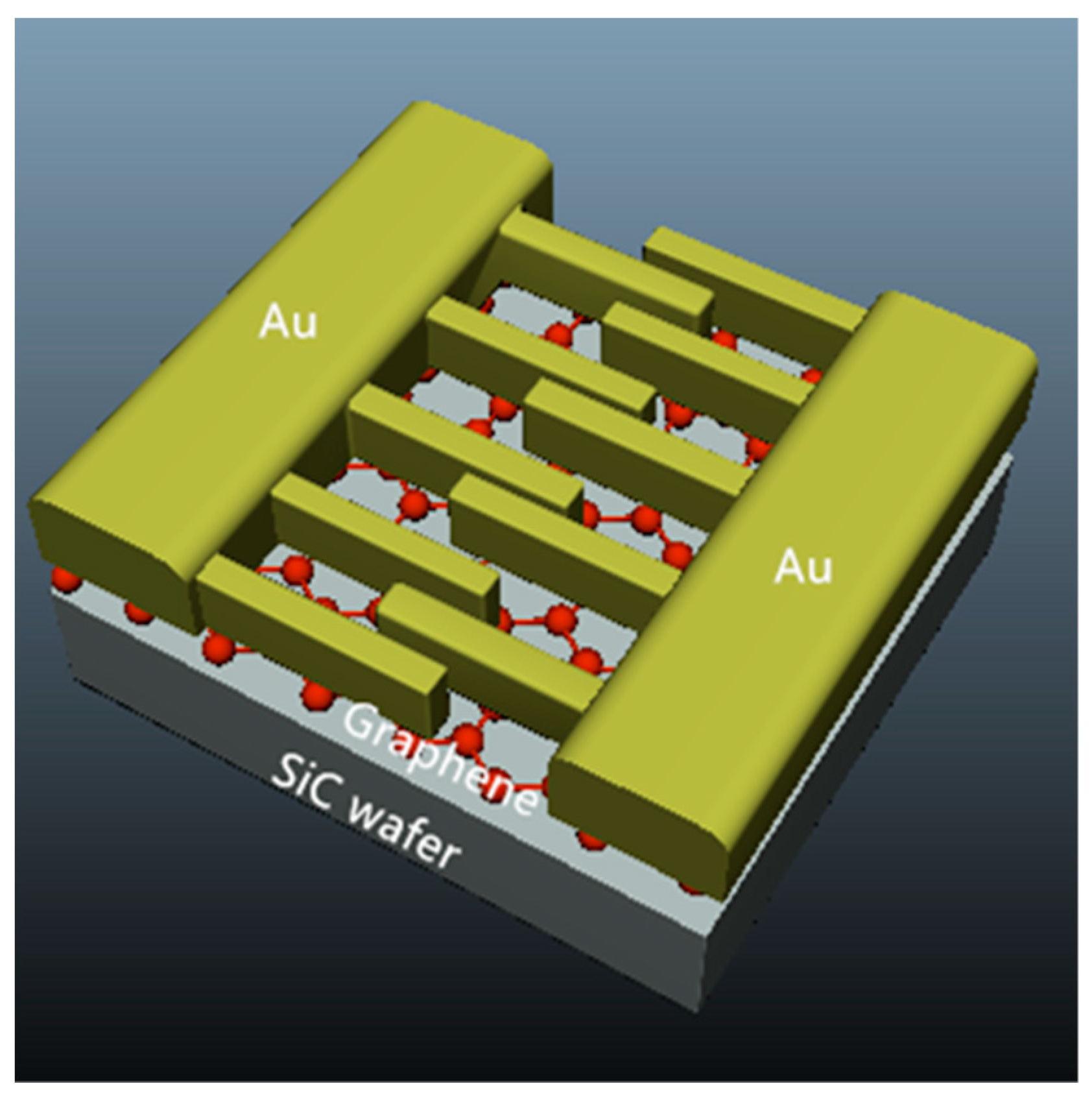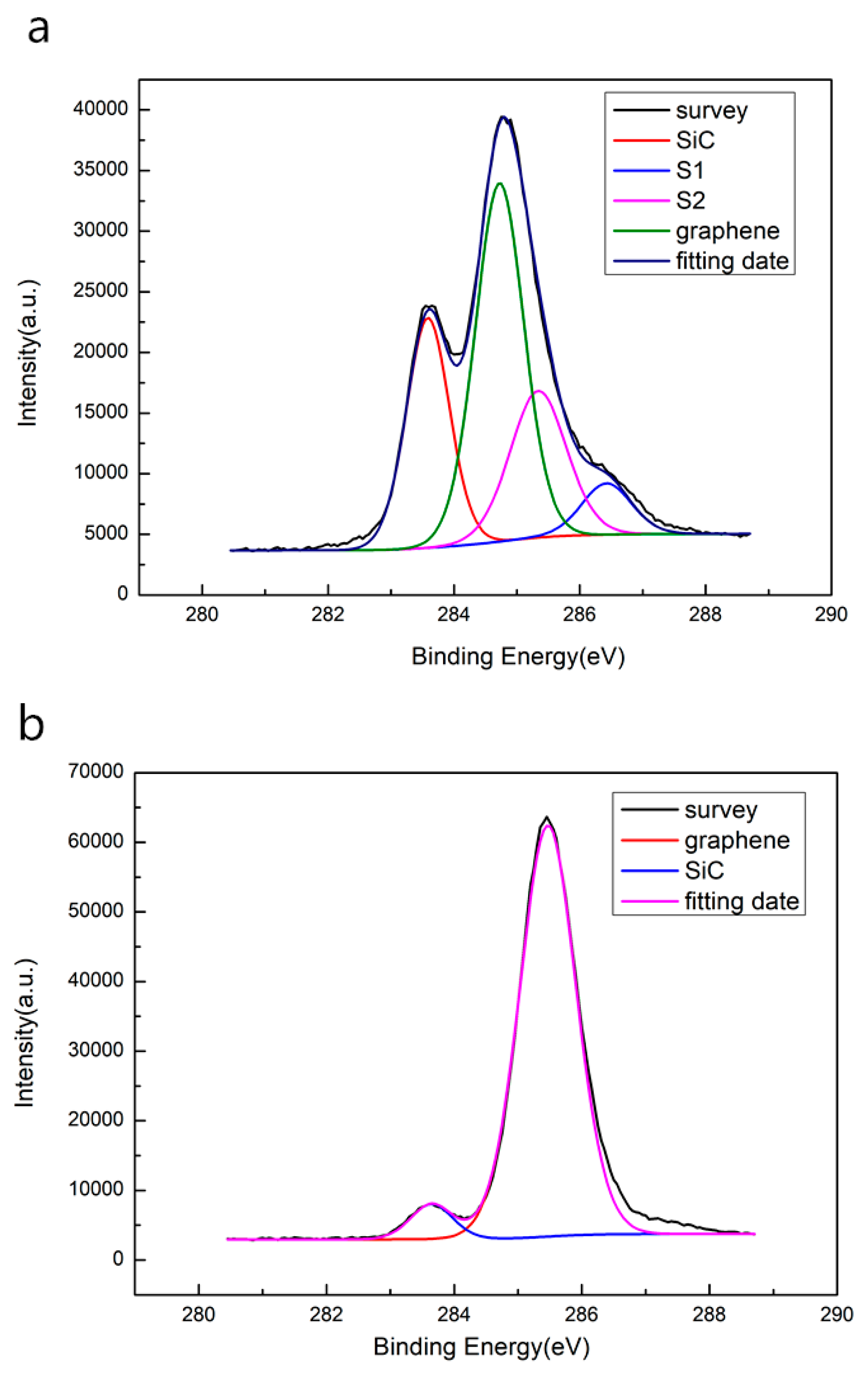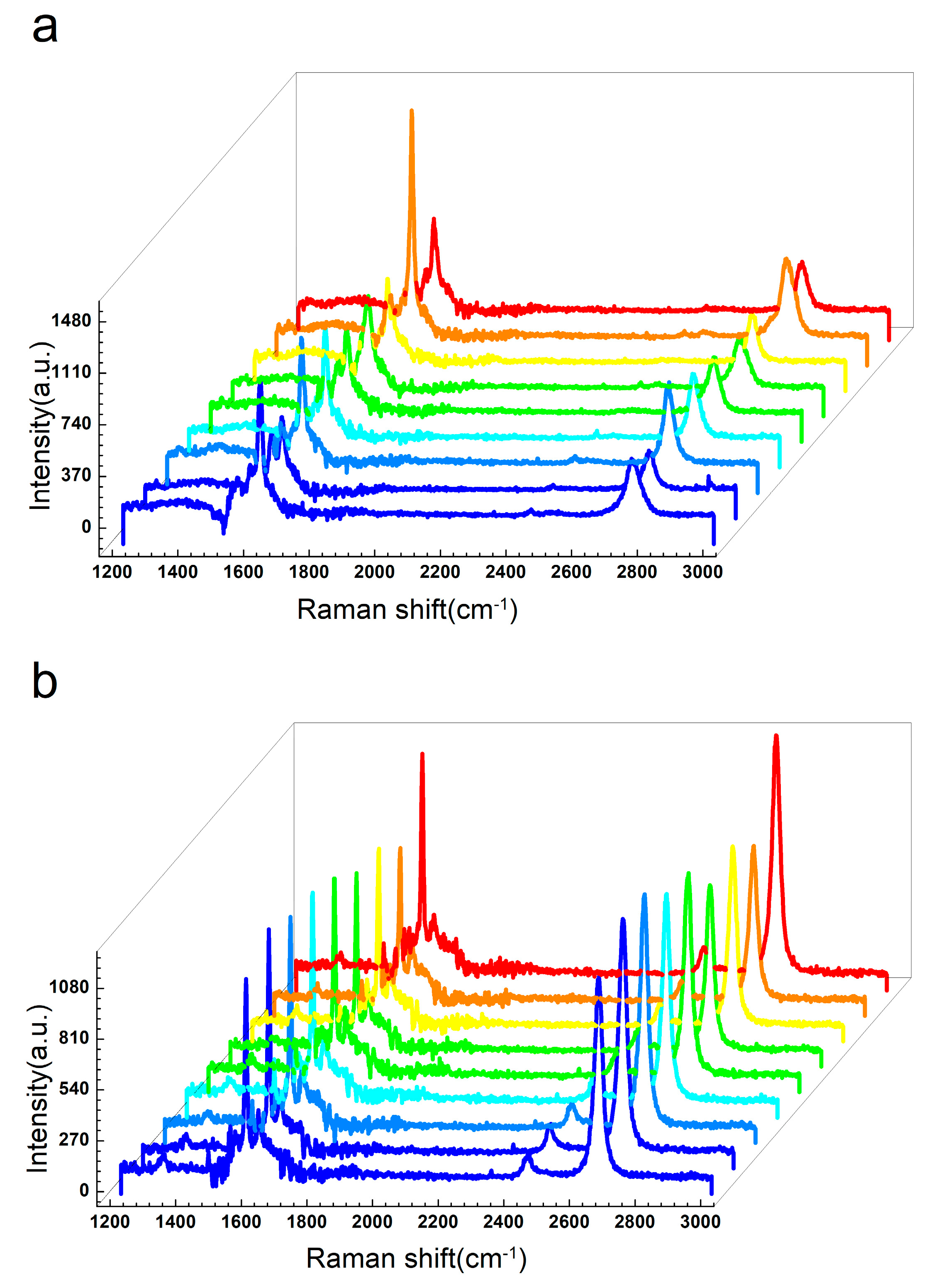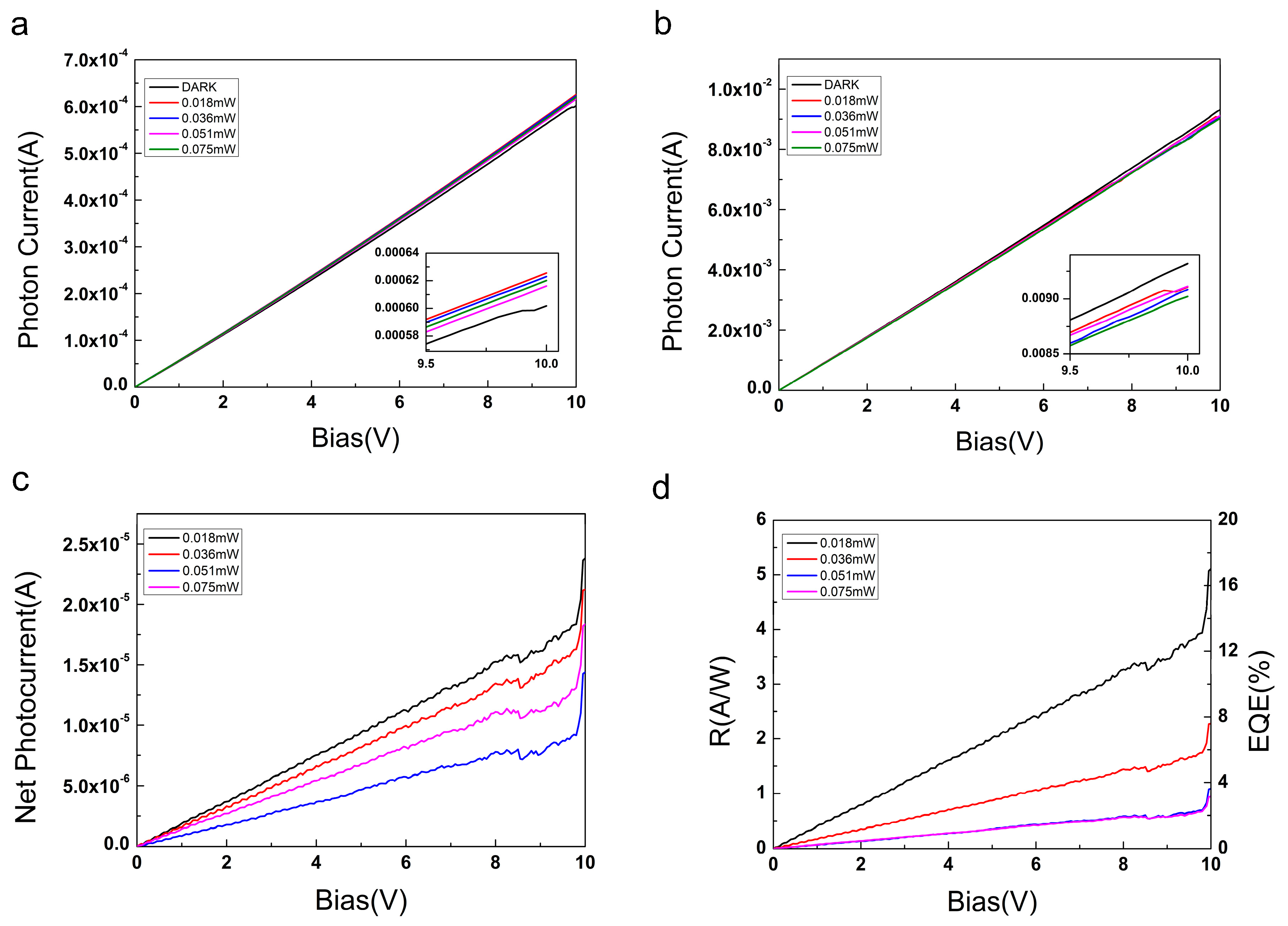Enhanced Performance of a Visible Light Detector Made with Quasi-Free-Standing Graphene on SiC
Abstract
1. Introduction
2. Materials and Methods
2.1. Preparation of EG and QFSG
2.2. Fabrication of the MGM Photodetector
3. Results and Discussion
4. Conclusions
Supplementary Materials
Author Contributions
Funding
Conflicts of Interest
References
- Goossens, S.; Navickaite, G.; Monasterio, C.; Gupta, S.; Piqueras, J.J.; Pérez, R.; Burwell, G.; Nikitskiy, I.; Lasanta, T.; Galán, T.; et al. Broadband image sensor array based on graphene–CMOS integration. Nat. Photonics 2017, 11, 366–371. [Google Scholar] [CrossRef]
- Wang, X.; Cheng, Z.; Xu, K.; Tsang, H.K.; Xu, J.B. High-responsivity graphene/silicon-heterostructure waveguide photodetectors. Nat. Photonics 2013, 7, 888–891. [Google Scholar] [CrossRef]
- Umana-Membreno, G.A.; Kala, H.; Antoszewski, J.; Ye, Z.H. Depth profiling of electronic transport parameters inn-on-p Boron-ion-implanted vacancy-doped HgCdTe. J. Electron. Mater. 2013, 42, 3108–3113. [Google Scholar] [CrossRef]
- Saidaminov, M.I.; Haque, M.A.; Savoie, M.; Abdelhady, A.L.; Cho, N.; Dursun, I.; Buttner, U.; Alarousu, E.; Wu, T.; Bakr, O.M. Perovskite photodetectors operating in both narrowband and broadband regimes. Adv. Mater. 2016, 28, 8144–8149. [Google Scholar] [CrossRef] [PubMed]
- Alwadai, N.; Haque, M.A.; Mitra, S.; Flemban, T.; Pak, Y.; Wu, T.; Roqan, I. High-performance ultraviolet-to-infrared broadband perovskite photodetectors achieved via inter-/intraband transitions. ACS Appl. Mater. Interfaces 2017, 9, 37832–37838. [Google Scholar] [CrossRef] [PubMed]
- Balandin, A.A.; Nika, D.L. Phononics in low-dimensional materials. Mater. Today 2012, 15, 266–275. [Google Scholar] [CrossRef]
- Yoffe, A.D. Semiconductor quantum dots and related systems: Electronic, optical, luminescence and related properties of low dimensional systems. Adv. Phys. 2001, 50, 1–208. [Google Scholar] [CrossRef]
- Dresselhaus, M.S.; Chen, G.; Tang, M.Y.; Yang, R.; Gogna, P. New directions for low-dimensional thermoelectric materials. Adv. Mater. 2007, 19, 1043–1053. [Google Scholar] [CrossRef]
- Woestenborghs, W.; Visschere, P.D.; Beunis, F.; Neyts, K. A two-dimensional model for an in-plane organic photo-conductive bilayer sensor. J. Phys. D Appl. Phys. 2014, 47, 355103. [Google Scholar] [CrossRef]
- Chen, Z.; Cheng, Z.; Wang, J.; Wan, X.; Shu, C.; Tsang, H.K.; Ho, H.P.; Xu, J.B. High responsivity, broadband and fast graphene/silicon photodetector in photoconductor mode. Adv. Opt. Mater. 2015, 3, 1207–1214. [Google Scholar] [CrossRef]
- Georgiou, T.; Jalil, R.; Belle, B.D.; Britnell, L.; Gorbachev, R.V.; Morozov, S.V.; Kim, Y.; Gholinia, A.; Haigh, S.J.; Makarovsky, O.; et al. Vertical field-effect transistor based on graphene–ws2 heterostructures for flexible and transparent electronics. Nat. Nanotechnol. 2012, 8, 100–103. [Google Scholar] [CrossRef] [PubMed]
- Koppens, F.H.L.; Mueller, T.; Avouris, P.; Ferrari, A.C.; Vitiello, M.S.; Polini, M. Photodetectors based on graphene, other two-dimensional materials and hybrid systems. Nat. Nanotechnol. 2014, 9, 780–793. [Google Scholar] [CrossRef] [PubMed]
- Kravets, V.G.; Grigorenko, A.N.; Nair, R.R.; Blake, P.; Anissimova, S.; Novoselov, K.S.; Geim, A.K. Spectroscopic ellipsometry of graphene and an exciton-shifted van Hove peak in absorption. Phys. Rev. B 2010, 81, 155413. [Google Scholar] [CrossRef]
- Balandin, A.A.; Ghosh, S.; Bao, W.; Calizo, I.; Teweldebrhan, D.; Miao, F.; Lau, C.N. Superior thermal conductivity of single-layer graphene. Nano Lett. 2008, 8, 902–907. [Google Scholar] [CrossRef] [PubMed]
- Marconcini, P.; Macucci, M. Approximate calculation of the potential profile in a graphene-based device. IET Circuits Devices Syst. 2015, 9, 30–38. [Google Scholar] [CrossRef][Green Version]
- Cui, Q.; Yang, Y.; Li, J.; Teng, F.; Wang, X. Material and Device Architecture Engineering Toward High Performance Two-Dimensional (2D) Photodetectors. Crystals 2017, 7, 149. [Google Scholar] [CrossRef]
- Liu, C.H.; Chang, Y.C.; Norris, T.B.; Zhong, Z. Graphene photodetectors with ultra-broadband and high responsivity at room temperature. Nat. Nanotechnol. 2014, 9, 273–278. [Google Scholar] [CrossRef]
- Kim, M.; Choi, S.; Yoon, H.A.; Choi, S.K.; Lee, J.; Kim, J.; Lee, S.W.; Son, Y.; Cheong, H. Photocurrent generation at ABA/ABC lateral junction in tri-layer graphene photodetector. Carbon 2016, 96, 454–458. [Google Scholar] [CrossRef]
- Chen, Z.; Li, X.; Wang, J.; Tao, L.; Long, M.; Liang, S.; Ang, L.K.; Shu, C.; Tsang, H.K.; Xu, J. Synergistic effects of plasmonics and electrons trapping in graphene short-wave infrared photodetectors with ultrahigh responsivity. ACS Nano 2016, 11, 430. [Google Scholar] [CrossRef]
- Li, X.; Yan, Y.; Dong, L.; Guo, J.; Aiyiti, A.; Xu, X.; Li, B. Thermal conduction across a boron nitride and SiO2 interface. J. Phys. D Appl. Phys. 2017, 50, 104002. [Google Scholar] [CrossRef]
- Shemella, P.; Zhang, Y.; Mailman, M.; Ajayan, P.M.; Nayak, S.K. Energy gaps in zero-dimensional graphene nanoribbons. Appl. Phys. Lett. 2007, 91, 042101. [Google Scholar] [CrossRef]
- Yavari, F.; Kritzinger, C.; Gaire, C.; Song, L.; Gulapalli, H.; Borca-Tasciuc, T.; Ajayan, P.M.; Koratkar, N. Tunable bandgap in graphene by the controlled adsorption of water molecules. Small 2010, 6, 2535–2538. [Google Scholar] [CrossRef] [PubMed]
- Ohta, T.; Bostwick, A.; Seyller, T.; Horn, K.; Rotenberg, E. Controlling the electronic structure of bilayer graphene. Science 2006, 313, 951–954. [Google Scholar] [CrossRef] [PubMed]
- Yu, C.; Li, J.; Liu, Q.B.; Dun, S.B.; He, Z.Z.; Zhang, X.W.; Cai, S.J.; Feng, Z.H. Buffer layer induced band gap and surface low energy optical phonon scattering in epitaxial graphene on sic (0001). Appl. Phys. Lett. 2013, 102, 013107. [Google Scholar] [CrossRef]
- Lee, E.J.H.; Balasubramanian, K.; Weitz, R.T.; Burghard, M.; Kern, K. Contact and edge effects in graphene devices. Nat. Nanotechnol. 2008, 3, 486–490. [Google Scholar] [CrossRef] [PubMed]
- Riedl, C.; Coletti, C.; Iwasaki, C.; Zakharov, A.A.; Starke, U. Quasi-Free-Standing Epitaxial Graphene on SiC Obtained by Hydrogen Intercalation. Phys. Rev. Lett. 2009, 103, 246804. [Google Scholar] [CrossRef]
- Melios, C.; Panchal, V.; Giusca, C.E.; Strupiński, W.; Kazakova, O. Carrier type inversion in quasi-free standing graphene: Studies of local electronic and structural properties. Sci. Rep. 2015, 5, 10505. [Google Scholar] [CrossRef]
- Mallet, P.; Varchon, F.; Naud, C.; Magaud, L.; Berger, C.; Veuillen, J.Y. Electron states of mono- and bilayer graphene on SiC probed by STM. Phys. Rev. B 2007, 76, 041403. [Google Scholar] [CrossRef]
- Ferrah, D.; Penuelas, J.; Bottela, C.; Grenet, G.; Ouerghi, A. X-ray photoelectron spectroscopy (XPS) and diffraction (XPD) study of a few layers of graphene on 6H-SiC (0001). Surf. Sci. 2013, 615, 47–56. [Google Scholar] [CrossRef]
- Ferrari, A.C.; Basko, D.M. Raman spectroscopy as a versatile tool for studying the properties of graphene. Nat. Nanotechnol. 2013, 8, 235–246. [Google Scholar] [CrossRef]
- Potbhare, S.; Goldsman, N.; Pennington, G.; Lelis, A.; Mcgarrity, J.M. A quasi-two-dimensional depth-dependent mobility model suitable for device simulation for coulombic scattering due to interface trapped charges. J. Appl. Phys. 2006, 100, 44516. [Google Scholar] [CrossRef]
- Li, Q.; Das, S.S. Finite temperature inelastic mean free path and quasiparticle lifetime in graphene. Phys. Rev. B 2013, 87, 085406. [Google Scholar] [CrossRef]
- Lemme, M.C.; Koppens, F.H.L.; Falk, A.L.; Rudner, M.S.; Park, H.; Levitov, L.S.; Marcus, C.M. Gate-activated photoresponse in a graphene p–n junction. Nano Lett. 2011, 11, 4134–4137. [Google Scholar] [CrossRef] [PubMed]





© 2019 by the authors. Licensee MDPI, Basel, Switzerland. This article is an open access article distributed under the terms and conditions of the Creative Commons Attribution (CC BY) license (http://creativecommons.org/licenses/by/4.0/).
Share and Cite
Li, X.; Chen, X.; Xu, X.; Hu, X.; Zuo, Z. Enhanced Performance of a Visible Light Detector Made with Quasi-Free-Standing Graphene on SiC. Materials 2019, 12, 3227. https://doi.org/10.3390/ma12193227
Li X, Chen X, Xu X, Hu X, Zuo Z. Enhanced Performance of a Visible Light Detector Made with Quasi-Free-Standing Graphene on SiC. Materials. 2019; 12(19):3227. https://doi.org/10.3390/ma12193227
Chicago/Turabian StyleLi, Xiaomeng, Xiufang Chen, Xiangang Xu, Xiaobo Hu, and Zhiyuan Zuo. 2019. "Enhanced Performance of a Visible Light Detector Made with Quasi-Free-Standing Graphene on SiC" Materials 12, no. 19: 3227. https://doi.org/10.3390/ma12193227
APA StyleLi, X., Chen, X., Xu, X., Hu, X., & Zuo, Z. (2019). Enhanced Performance of a Visible Light Detector Made with Quasi-Free-Standing Graphene on SiC. Materials, 12(19), 3227. https://doi.org/10.3390/ma12193227




